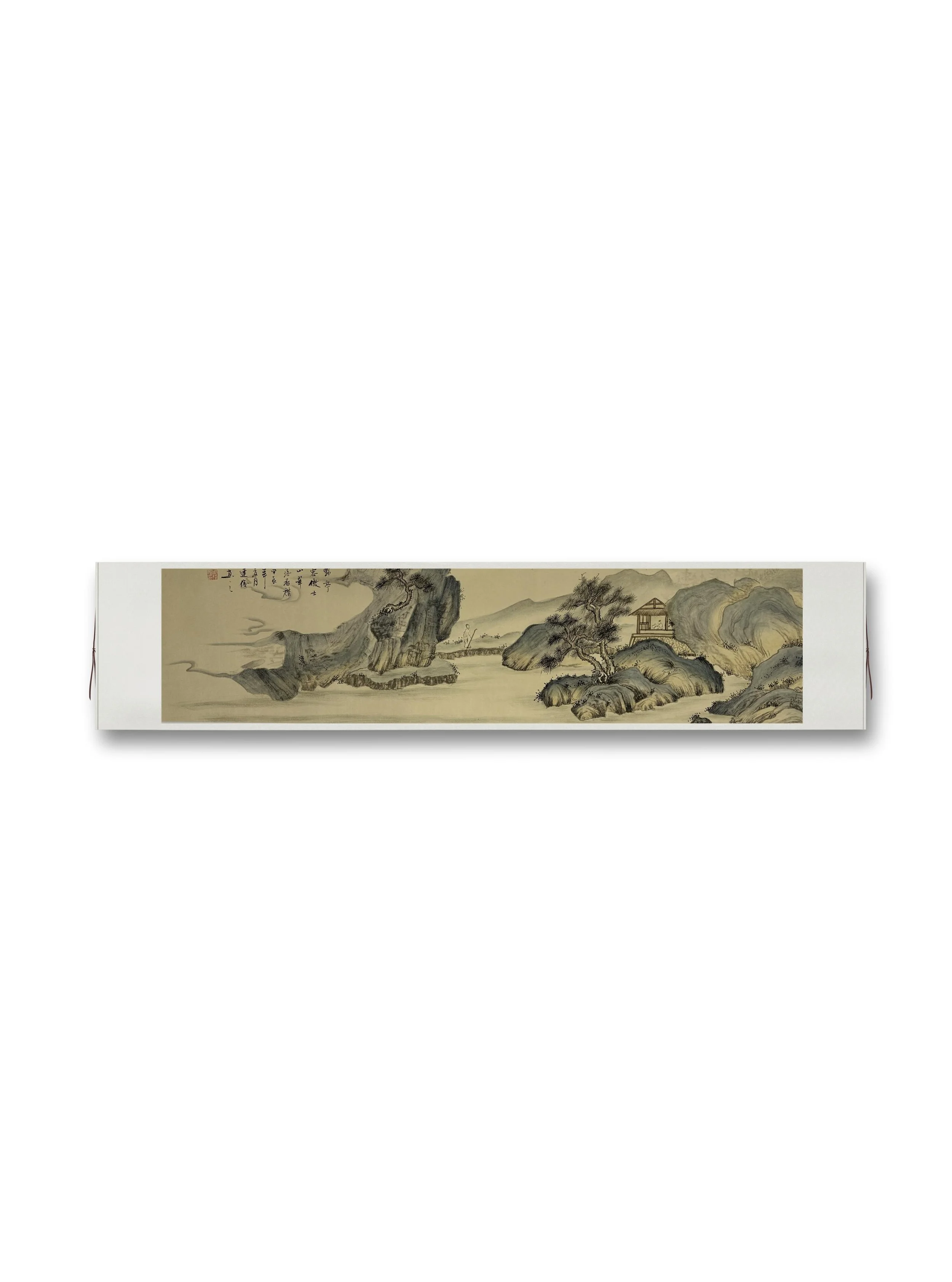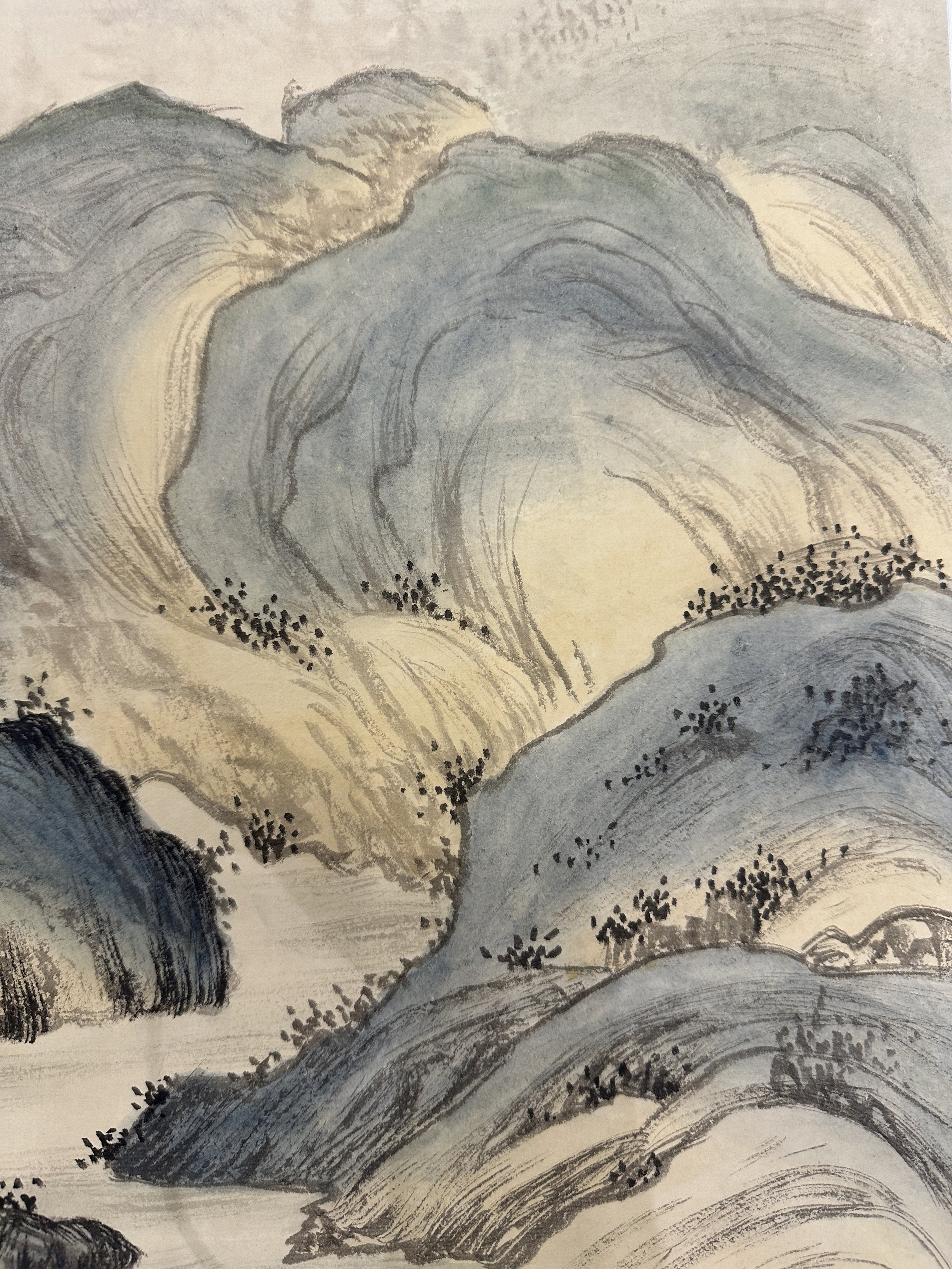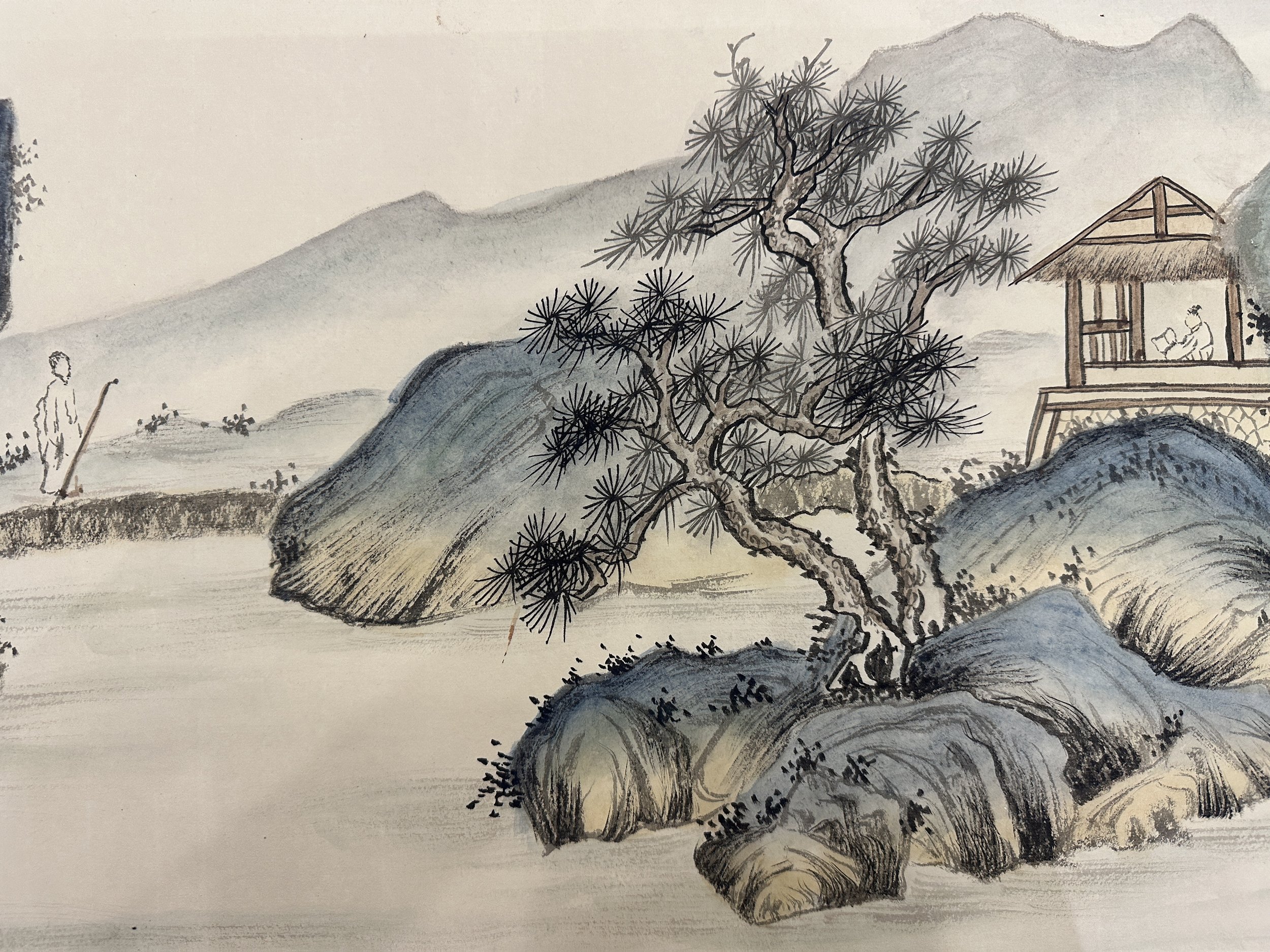 Image 1 of 7
Image 1 of 7

 Image 2 of 7
Image 2 of 7

 Image 3 of 7
Image 3 of 7

 Image 4 of 7
Image 4 of 7

 Image 5 of 7
Image 5 of 7

 Image 6 of 7
Image 6 of 7

 Image 7 of 7
Image 7 of 7








幽崖静居 Retreat Amid Verdant Cliffs
Core size:35cm*138cm
1. Brushwork Techniques:
• The rocks and cliffs are rendered with bold, angular brushstrokes, creating a sense of strength and permanence. The artist likely used “axe-cut” texture strokes (斧劈皴), a classic technique for depicting rugged mountain faces.
• The trees and foliage are painted with fine, controlled brushstrokes, suggesting vitality and attention to detail.
• The water and sky are left unpainted, using negative space to create contrast and evoke tranquility.
2. Use of Color:
• The muted tones—soft greens, ochres, and grays—harmonize with the natural subject matter, conveying a sense of timelessness.
• The subtle color washes over the rocks and pavilion hint at careful layering, a hallmark of traditional Chinese scroll painting.
3. Perspective:
• The scroll employs “floating perspective” (散点透视), where multiple viewpoints are presented simultaneously. This allows viewers to experience different parts of the landscape as if they are wandering through it, rather than observing from a fixed point.
Cultural and Symbolic Significance
1. The Pavilion:
• The pavilion represents a place of solitude and contemplation. In Chinese culture, such structures are often built in scenic areas for scholars or poets seeking inspiration.
• Its placement among the rocks and trees signifies harmony between human creation and nature, echoing Confucian ideals of balance.
2. Pathways and Bridges:
• The pathways in the painting symbolize a journey, not just physical but also spiritual or intellectual. In traditional Chinese art, these journeys often lead to self-discovery or enlightenment.
• The small bridge in the painting serves as a metaphor for crossing obstacles or connecting two realms, such as the material and spiritual worlds.
3. Daoist and Confucian Influences:
• The painting reflects Daoist philosophy, emphasizing the natural world’s ability to guide and heal the human spirit.
• At the same time, the orderly arrangement of the landscape—where every element has its place—resonates with Confucian ideals of harmony and structure in life.
Narrative Possibilities
This painting may tell a story or evoke an imagined scene. For example:
• A scholar may have retreated to this quiet spot to escape the chaos of the outside world and find inspiration in nature.
• The pavilion could represent a meeting place for like-minded individuals—poets, artists, or Daoist sages.
The elements of the painting work together to create a narrative of retreat, reflection, and connection with nature.
Core size:35cm*138cm
1. Brushwork Techniques:
• The rocks and cliffs are rendered with bold, angular brushstrokes, creating a sense of strength and permanence. The artist likely used “axe-cut” texture strokes (斧劈皴), a classic technique for depicting rugged mountain faces.
• The trees and foliage are painted with fine, controlled brushstrokes, suggesting vitality and attention to detail.
• The water and sky are left unpainted, using negative space to create contrast and evoke tranquility.
2. Use of Color:
• The muted tones—soft greens, ochres, and grays—harmonize with the natural subject matter, conveying a sense of timelessness.
• The subtle color washes over the rocks and pavilion hint at careful layering, a hallmark of traditional Chinese scroll painting.
3. Perspective:
• The scroll employs “floating perspective” (散点透视), where multiple viewpoints are presented simultaneously. This allows viewers to experience different parts of the landscape as if they are wandering through it, rather than observing from a fixed point.
Cultural and Symbolic Significance
1. The Pavilion:
• The pavilion represents a place of solitude and contemplation. In Chinese culture, such structures are often built in scenic areas for scholars or poets seeking inspiration.
• Its placement among the rocks and trees signifies harmony between human creation and nature, echoing Confucian ideals of balance.
2. Pathways and Bridges:
• The pathways in the painting symbolize a journey, not just physical but also spiritual or intellectual. In traditional Chinese art, these journeys often lead to self-discovery or enlightenment.
• The small bridge in the painting serves as a metaphor for crossing obstacles or connecting two realms, such as the material and spiritual worlds.
3. Daoist and Confucian Influences:
• The painting reflects Daoist philosophy, emphasizing the natural world’s ability to guide and heal the human spirit.
• At the same time, the orderly arrangement of the landscape—where every element has its place—resonates with Confucian ideals of harmony and structure in life.
Narrative Possibilities
This painting may tell a story or evoke an imagined scene. For example:
• A scholar may have retreated to this quiet spot to escape the chaos of the outside world and find inspiration in nature.
• The pavilion could represent a meeting place for like-minded individuals—poets, artists, or Daoist sages.
The elements of the painting work together to create a narrative of retreat, reflection, and connection with nature.
Core size:35cm*138cm
1. Brushwork Techniques:
• The rocks and cliffs are rendered with bold, angular brushstrokes, creating a sense of strength and permanence. The artist likely used “axe-cut” texture strokes (斧劈皴), a classic technique for depicting rugged mountain faces.
• The trees and foliage are painted with fine, controlled brushstrokes, suggesting vitality and attention to detail.
• The water and sky are left unpainted, using negative space to create contrast and evoke tranquility.
2. Use of Color:
• The muted tones—soft greens, ochres, and grays—harmonize with the natural subject matter, conveying a sense of timelessness.
• The subtle color washes over the rocks and pavilion hint at careful layering, a hallmark of traditional Chinese scroll painting.
3. Perspective:
• The scroll employs “floating perspective” (散点透视), where multiple viewpoints are presented simultaneously. This allows viewers to experience different parts of the landscape as if they are wandering through it, rather than observing from a fixed point.
Cultural and Symbolic Significance
1. The Pavilion:
• The pavilion represents a place of solitude and contemplation. In Chinese culture, such structures are often built in scenic areas for scholars or poets seeking inspiration.
• Its placement among the rocks and trees signifies harmony between human creation and nature, echoing Confucian ideals of balance.
2. Pathways and Bridges:
• The pathways in the painting symbolize a journey, not just physical but also spiritual or intellectual. In traditional Chinese art, these journeys often lead to self-discovery or enlightenment.
• The small bridge in the painting serves as a metaphor for crossing obstacles or connecting two realms, such as the material and spiritual worlds.
3. Daoist and Confucian Influences:
• The painting reflects Daoist philosophy, emphasizing the natural world’s ability to guide and heal the human spirit.
• At the same time, the orderly arrangement of the landscape—where every element has its place—resonates with Confucian ideals of harmony and structure in life.
Narrative Possibilities
This painting may tell a story or evoke an imagined scene. For example:
• A scholar may have retreated to this quiet spot to escape the chaos of the outside world and find inspiration in nature.
• The pavilion could represent a meeting place for like-minded individuals—poets, artists, or Daoist sages.
The elements of the painting work together to create a narrative of retreat, reflection, and connection with nature.
Return & Exchange Policy
At Momoon Art, each painting is a one-of-a-kind creation. As such, we do not accept returns or exchanges unless the item arrives damaged during the delivery process.
If your artwork is damaged upon arrival, please contact us within [7 days] of receiving your order. We will gladly offer a refund or exchange once the damage is verified.
Thank you for understanding and supporting unique, handcrafted art!
